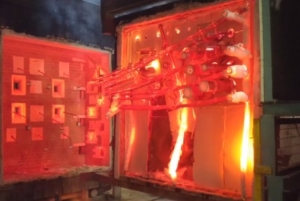What material should the first service support be? Firestopping FAQs
The first service support plays a crucial role in the firestop seal system. It’s not just about providing adequate support for the services, but also about preventing any load from being transferred onto the service penetration seal. This is a critical function, both in the building’s normal lifecycle and in the event of a fire.
The below picture shows the inside of a furnace at the end of a fire test, highlighting the importance of the service support:

While we often discuss the importance of spacing regarding the first service support, it’s equally crucial to consider the material it’s made from. The choice of material can significantly impact the performance of the service support.
As per the BS EN 1366-3:2021 fire-resistance test standard, the service support should be non-combustible and made from steel unless tested otherwise.
Section H.4.2.2 states the following:
H.4.2.2 Service Support Material
Steel grade S235JR (1.0038), in accordance with EN 10025-2, is recommended for steel parts that form a service support construction. For steel angles, EN 10056-1 is recommended for steel channels EN 10162 (cold-rolled) or EN 10279 (hot-rolled).
When other materials than steel are intended to be used for cable carriers, a separate assessment is necessary. To make sure test conditions in terms of load are comparable to the standard configuration situation the cables of ladder 1 of the standard configuration were chosen, as they comprise of the biggest cables.
Quelfire typically uses steel strut systems and steel drop rods with cable clamps to support the service penetrations when fire testing. This is at the first service support distance stated on our detail drawings.
Combustible materials such as plastic zip ties, commonly used for single cables, have not been fire tested and should not be used as a service support through a fire-separating element.
If you have any further questions, please don’t hesitate to contact us at technical@quelfire.co.uk.

